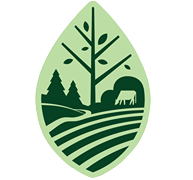AFTA Session
Day 4 – Wednesday, Dec. 9th, 2020
11am – 12:20pm
AFTA Session

North Shore AgroEcology Center/Organic Consumers Assoc. Regenerative Farming in NE Minnesota – The North Shore AgroEcology Center
Stefan Meyer, Farm Manager – North Shore AgroEcology Center
A new regenerative farm and educational site is being developed by the Organic Consumers Association on the Minnesota North Shore. Join us as we walk through the land development work that has happened over the last 4 years; from design to earth works, to soil improvement and hugelkultur. We have incorporated multiple elements, such as: mushrooms, bees, fruits and nuts, a deep winter greenhouse, grape mash/wood chip/mushroom composting windrows, herb gardens, woodland management for sugarbush, solar arrays, to a multrum composting toilet. We are trialing out hazelnut and elderberry varieties for our area. The farm will be used for education, demonstration and experimentation of regenerative agriculture techniques.
Shrub Willows as Living Snow Fences in Minnesota
Gary Wyatt, University of Minnesota Extension
Living snow fences (LSFs) are rows of trees, shrubs, grasses, or standing corn that are strategically placed to control drifting snow on rural roadways. LSFs are an agroforestry practice that can provide a range of environmental benefits, including wildlife habitat and carbon sequestration. Blowing and drifting snow adversely affects winter driving conditions and increases road maintenance costs. Despite incentives and financial assistance by state and federal agencies, farmer adoption of LSFs is low, due to concerns about removing cropland from production, among other reasons. There has been an interest in using shrub-willows (Salix spp.) as LSFs in Minnesota?, because they have been successfully implemented for LSFs in other states and are considered a short-rotation woody crop for bioenergy production. To evaluate the potential of shrub willow LSFs for multiple benefits in Minnesota, a right-of-way demonstration LSF was established in 2017. This LSF was so successful that the Minnesota Department of Transportation (MnDOT) has planted several more willow LSF around the state. Learn more about the willow LSF story in Minnesota.
Download the Living Fences with Shrub Willows Fact Sheet
The Influence of Environmental Factors on Plantings of Wild-Simulated American Ginseng
Karam Sheban, Post-Graduate Research Fellow at Yale University, School of the Environment
Anna Plattner, General Manager at American Ginseng Pharm
Forest farming is the cultivation of high-value crops under the protection of a tree canopy. Due to reliable markets and its high commodity value, American ginseng (Panax quinquefolius L.) is often the focus crop of forest farming operations in the Eastern United States. By number of growers, American ginseng is primarily grown using wild-simulated planting techniques aiming to mimic the natural habitat of wild ginseng.
Wild-simulated ginseng producers largely rely on conventional wisdom—learned from wild-harvesting ginseng—when selecting sites for intentional cultivation; sites are selected based on slope, aspect, and presence of indicator species. However, these are all proxy variables and do not reveal how plants are interacting with the direct environmental variables that influence plant growth (e.g., light, moisture, nutrients). Sites which seem comparable based on their slope, aspect, and associated species yield very different rates of germination and ginseng survival over time, resulting in mixed success of plantings.
In partnership with American Ginseng Pharm—a wild-simulated ginseng farm with plantings across more than 1,000 forested acres in the Catskill Mountains—Karam Sheban conducted research funded by the USDA’s SARE program into the environmental factors responsible for the growth and development of plantings of wild-simulated ginseng. Project results contribute to our understanding of what environmental variables are most critical for the success of wild-simulated ginseng plantings.
In their talk, Karam and Anna will present on this research—currently in preparation for publication—and how it has helped guide American Ginseng Pharm’s management. They will also discuss the implications for forest farmers across the region.
Using Bark Mulch to Control Weeds and Build Soils In Organic Apples
Chris McGuire, Two Onion Farm
Most new commercial apple orchards are planted with dwarf trees, which provide a rapid return on investment, reduce labor requirements, reduce disease pressure, and improve fruit quality. However, dwarf trees compete poorly with neighboring plants. Non-organic growers typically use chemical herbicides to control weeds under trees, but organic growers have fewer options.
We share results, including material costs and labor requirements, from our ten years of experience raising organic apples in southwestern Wisconsin. We mulch under our trees with hardwood bark, which discourages vole pests, builds soil organic matter, and suppresses weeds. Annual mulching in our orchard requires $2.50 per tree per year for bark and 3 minutes per tree per year in labor.
We have found several challenges with this mulch system: (1) Weeds with wind-dispersed seeds (dandelions) germinate atop the mulch and require additional wedding. (2) Slow-spreading grass and clover from the aisles in between tree rows gradually encroach into the mulch. Tractor cultivation of a narrow strip between the sod and the mulch controls this problem. (3) Perennial weeds with deep rhizomes, such as Canada Thistle, can establish in the mulch and form dense patches. Established patches can be controlled by repeatedly killing weed shoots during the growing season. Organic herbicides, string-trimming, and hoeing are all effective methods of killing shoots, each with different advantages and costs.(Part of this presentation is based on the results of a USDA-SARE farmer rancher grant to study methods of Canada thistle control in mulched organic orchards.)

